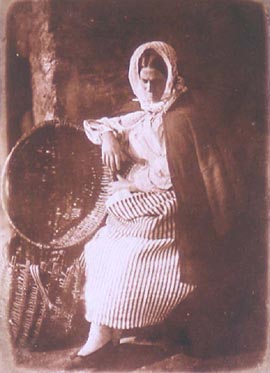David Octavius Hill and Robert Adamson

Salted-paper print from a calotype
negative, around 1843.
[Library reference: FB.el.20]
David Octavius Hill (1802-1870) and Robert Adamson (1821-1848) are regarded as the most important photographers working in Scotland in the decade following the public announcement of the discovery of photography in 1839.
They have remained enormously influential on the development of Scottish photography right up to the present day.
Based in Edinburgh, they were among the first photographers in Scotland to use Talbot's calotype process – which brought the concepts of negative and positive into photographic usage.
Newhaven image
This image is from the series known as the 'Great Newhaven Project'.
In this project the photographers used the camera to document the fishing communities living in the villages on the banks of the Firth of Forth during the mid-1840s.
It is taken from one of three large albums containing almost 300 Hill and Adamson prints in the National Library of Scotland.
Film about Hill and Adamson
A 15-minute film about David Octavius Hill and Robert Adamson is available to watch on the National Library of Scotland's Moving Image Archive catalogue. Made in 1965, with the Library's assistance, the film is described as 'a history of the pioneers of photography'. Watch 'The Sun Pictures' film
